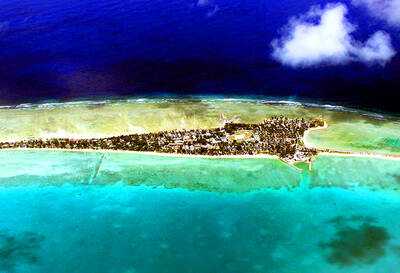Representatives of 30 nations were yesterday to meet to seek ways to save fast-depleting tuna stocks in the Indian Ocean as demand in Asia and the West soars for sushi and canned fish.
The Indian Ocean Tuna Commission (IOTC), which groups coastal countries from Australia to Kenya plus major fishing region the EU, was convening virtually over five days to debate yellowfin tuna quotas.
Environmentalists have said the warm-water species is at risk of depletion as overfishing compounds other threats from climate change and pollution.
There is corporate concern, too: British supermarkets Tesco and Co-op, and Belgian retailer Colruyt last year pledged to stop buying Indian Ocean yellowfin unless the UN-mandated commission adopts a plan to rebuild stocks.
The International Union for Conservation of Nature has for nearly a decade had the species on its “red list.”
Yet the total global catch has risen by about one-third, to nearly 450,000 tonnes annually, according to the London-based Blue Marine Foundation advocacy group.
It has estimated that yellowfin tuna stocks could “collapse” — meaning they would go beyond the minimum size needed for recovery — within the next five years if the catch is not cut.
French and Spanish fishing fleets take the majority of fish, using industrial methods such as “purse seine” with huge nets that often net juvenile yellowfin yet to begin reproducing.
Coastal nations want to limit Europe’s distant-water fleets.
Kenya and Sri Lanka, for example, want more curbs on devices such as fish aggregators: floating objects that attract tuna and other species toward nets.
“They are the visitors,” said Will McCallum, Head of Oceans at environmental group Greenpeace UK, of the European fleets. “They are fishing at a far larger capacity than anybody else, and it’s not an equitable state of affairs.”
The Maldives wants the yellowfin catch to be cut by 15 percent from 2015 levels, when IOTC scientists first agreed they were being overfished.
The IOTC had last year recommended cutting the catch by 20 percent from 2014 levels, but rowed back in January, saying that was distorted by projections from the 2018 stock assessment.
Given that a new stock assessment would not be ready until the end of this year, the commission might postpone new measures, the Blue Marine Foundation said.
“For a stock that is at risk of collapse, this delay could prove catastrophic,” it said in a statement.
The EU has proposed a total catch reduction from nearly 438,000 tonnes in 2019 to about 380,000.
Demand for yellowfin is booming as its light meat is widely used for canned fish and in sushi in North America, Europe and Asia. The global yellowfin market in 2018 was worth US$15.8 billion, the second-highest value of the seven tuna species, according to a report by the world’s largest canned tuna company, Thai Union Group.
McCallum said the overfishing issue had stalled during the COVID-19 pandemic and drastic action was needed now to avoid irrecoverable damage to the species.

DISASTER: The Bangladesh Meteorological Department recorded a magnitude 5.7 and tremors reached as far as Kolkata, India, more than 300km away from the epicenter A powerful earthquake struck Bangladesh yesterday outside the crowded capital, Dhaka, killing at least five people and injuring about a hundred, the government said. The magnitude 5.5 quake struck at 10:38am near Narsingdi, Bangladesh, about 33km from Dhaka, the US Geological Survey (USGS) said. The earthquake sparked fear and chaos with many in the Muslim-majority nation of 170 million people at home on their day off. AFP reporters in Dhaka said they saw people weeping in the streets while others appeared shocked. Bangladesh Interim Leader Muhammad Yunus expressed his “deep shock and sorrow over the news of casualties in various districts.” At least five people,

ON THE LAM: The Brazilian Supreme Court said that the former president tried to burn his ankle monitor off as part of an attempt to orchestrate his escape from Brazil Former Brazilian president Jair Bolsonaro — under house arrest while he appeals a conviction for a foiled coup attempt — was taken into custody on Saturday after the Brazilian Supreme Court deemed him a high flight risk. The court said the far-right firebrand — who was sentenced to 27 years in prison over a scheme to stop Brazilian President Luiz Inacio Lula da Silva from taking office after the 2022 elections — had attempted to disable his ankle monitor to flee. Supreme Court judge Alexandre de Moraes said Bolsonaro’s detention was a preventive measure as final appeals play out. In a video made

It is one of the world’s most famous unsolved codes whose answer could sell for a fortune — but two US friends say they have already found the secret hidden by Kryptos. The S-shaped copper sculpture has baffled cryptography enthusiasts since its 1990 installation on the grounds of the CIA headquarters in Virginia, with three of its four messages deciphered so far. Yet K4, the final passage, has kept codebreakers scratching their heads. Sculptor Jim Sanborn, 80, has been so overwhelmed by guesses that he started charging US$50 for each response. Sanborn in August announced he would auction the 97-character solution to K4

SHOW OF FORCE: The US has held nine multilateral drills near Guam in the past four months, which Australia said was important to deter coercion in the region Five Chinese research vessels, including ships used for space and missile tracking and underwater mapping, were active in the northwest Pacific last month, as the US stepped up military exercises, data compiled by a Guam-based group shows. Rapid militarization in the northern Pacific gets insufficient attention, the Pacific Center for Island Security said, adding that it makes island populations a potential target in any great-power conflict. “If you look at the number of US and bilateral and multilateral exercises, there is a lot of activity,” Leland Bettis, the director of the group that seeks to flag regional security risks, said in an